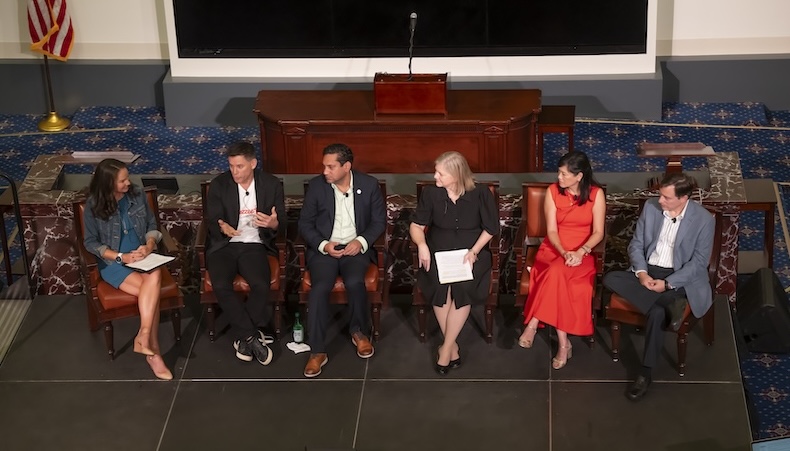How Leaders Are Fostering Fulfillment Through Engagement and Recognition


When working from home became a mandate during the pandemic, leaders at Prezzee scheduled a meeting and sent the workforce a gift card so everyone could get a coffee and cake delivered. This was the beginning of their morning tea, a celebration of achievement and opportunity to connect as the workforce moved to virtual. “It’s easy to connect when everyone is [together], now you’ve got to do it when not [physically together],” said Tony Karp, president, North America, at Prezzee.
For engagement to be impactful, the efforts have to be frequent, says Karp. “We found that the morning tea became the new water cooler conversation. Everyone scheduled it,” he said during a panel discussion at From Day One’s Boston conference. Efforts can be more than morale boosters: they’re a way to shape company culture, and research shows that they are less about the actual material reward and more about what it conveys.
As much as organizations can be excited about implementing new methods for recognition and rewards, there are several approaches to ensure the efforts resonate. Mike Dallas, the SVP, global head of employee experience at Manulife, says they rolled out a global recognition platform that enables employees at all levels across the globe to give and receive frequent and authentic recognition. The program, called podium, strived to “give people a podium,” he said. “We hope 75% of people give an award,” he said.
Julie Haskell, managing director, head of employee engagement at State Street Corp, believes in the power of simplicity. “Simplicity can be the easiest way to recognize someone,” she said. “Sometimes we fail to just say thank you and good job. There’s not one of us that does not feel better when recognized in a quick way.” Additionally, the power of gratitude is cross-generational, which is a way to side-step the extra hurdle posed by generational differences.

Karp says the ‘how’ matters as much as the ‘what.’ “Sending an email is passé, 12-second videos are too much for anyone under 15. The value is less relevant than how you get it and where it comes from,” he said.
Back to the Basics
Fancy features don’t matter if basic principles of good management are overlooked. “You need to focus on the basics: how is your performance management system? Is it intuitive? How is your talent acquisition process? Your talent development?” said Angela Cheng-Cimini, SVP, talent and CHRO at Harvard Business Publishing.
Sayar Lonial, associate dean, communications and public affairs at NYU Tandon School of Engineering, encourages people to really communicate. “I work at NYU, a very large university, and we try to support the thank-yous on a department level rather than top-down,” he said. “Department managers do a good job, and I have a lucky job of being in communications, so I hear the good and bad from our students and staff. We tell their story about how they made their community better.”
Different Needs and Formats
Navigating a multigenerational workforce with varying needs requires diverse solutions. “At Manulife, we started with a framing set of principles that outlines the basics on how and where you work,” said Dallas. “From a recognition standpoint, we make sure all of our populations get recognition: when we have employee events, most have video components. [We see] where common points between cohorts are, and how to address people in celebrating or learning from those events.”
Cheng-Cimini emphasizes the crucial role that managers play. “Are your managers skilled at expressing gratitude? All of us are busy, so we forget to pause and say thank you, and that is a skill that needs to be reinforced.” Another important point is asking the employee directly how they like to receive praise. “I know someone who hates public praise. Simply ask: how do you like to receive commendation? Do you want an email? Do you want a cash bonus? Do you like time off?” “And people feel included when you ask them!” Dallas added.
The Importance of Community
Working in a major city, Lonial recognizes that employees come from all walks of life, and this directly impacts their relationship with their community. “Embracing that community—we need to teach students and employees that they live in a larger world than their job,” he said. “They’re not defined by what their job is, they’re defined by who they are…what you bring to the table is what is going to make that place a better place to be,” he said.
Similarly, State Street is a big community, says Haskell. “One of the things we’ve learned is that we are really focused on skills-based volunteering. In a financial-service company, sometimes it’s hard to find a purpose,” said Haskell. She found out that a lot of their non-profit partners have trouble with skills her employees have, such as accounting and press releases. “I give back, I feel good, and I develop my skills.” When employees volunteer, they can fully display their skills. “People are coming out with skills that they have but don’t use on their day to day job,” she said.
Angelica Frey is a writer and a translator based in Boston and Milan.
The From Day One Newsletter is a monthly roundup of articles, features, and editorials on innovative ways for companies to forge stronger relationships with their employees, customers, and communities.